Comparative Inner Morphological and Chemical Studies on Reynoutria Species in Korea
Abstract
1. Introduction
2. Results and Discussion
2.1. Anatomical Characteristics of the Leaf
2.2. Anatomical Characteristics of the Midrib
2.3. Anatomical Characteristics of the Petiole
2.4. Anatomical Characteristics of the Stem
2.5. Anatomical Characteristics of the Root
2.6. HPLC–DAD Profiles of Reynoutria Plants
2.7. OPLS-DA Multivariate Statistical Analysis
3. Materials and Methods
3.1. Plant Materials and Reagents
3.2. Inner Morphological Study
3.3. Preparation of Extracts
3.4. HPLC–DAD Analysis
3.5. Statistical Analysis
4. Conclusions
Supplementary Materials
Author Contributions
Funding
Conflicts of Interest
References
- Patočka, J.; Navrátilová, Z.; Ovando, M. Biologically active compounds of knotweed (Reynoutria Spp.). Mil. Med. Sci. Lett. 2018, 86, 17–31. [Google Scholar]
- Peng, W.; Qin, R.; Li, X.; Zhou, H. Botany, phytochemistry, pharmacology, and potential application of Polygonum cuspidatum Sieb.et Zucc.: A review. J. Ethnopharmacol. 2013, 148, 729–745. [Google Scholar] [CrossRef] [PubMed]
- Dong, X.; Fu, J.; Yin, X.; Li, X.; Wang, B.; Cao, S.; Zhang, J.; Zhang, H.; Zhao, Y.; Ni, J. Pharmacological and other bioactivities of the genus Polygonum—A Review. Trop. J. Pharm. Res. 2014, 13, 1749–1759. [Google Scholar]
- Uddin, Z.; Song, Y.H.; Curtis-Long, M.J.; Kim, J.Y.; Yuk, H.J.; Park, K.H. Potent bacterial neuraminidase inhibitors, anthraquinone glucosides from Polygonum cuspidatum and their inhibitory mechanism. J. Ethnopharmacol. 2016, 193, 283–292. [Google Scholar] [CrossRef]
- Hwangbo, K.; Zheng, M.S.; Kim, Y.-J.; Im, J.-Y.; Lee, C.-S.; Woo, M.-H.; Jahng, Y.; Chang, H.-W.; Son, J.-K. Inhibition of DNA topoisomerases I and II of compounds from Reynoutria japonica. Arch. Pharmacal Res. 2012, 35, 1583–1589. [Google Scholar] [CrossRef]
- Lin, Y.-W.; Yang, F.-J.; Chen, C.-L.; Lee, W.-T.; Chen, R.-S. Free radical scavenging activity and antiproliferative potential of Polygonum cuspidatum root extracts. J. Nat. Med. 2010, 64, 146–152. [Google Scholar] [CrossRef]
- E Bralley, E.; Greenspan, P.; Hargrove, J.L.; Wicker, L.; Hartle, D.K. Topical anti-inflammatory activity of Polygonum cuspidatum extract in the TPA model of mouse ear inflammation. J. Inflamm. 2008, 5, 1. [Google Scholar] [CrossRef]
- Shan, B.; Cai, Y.-Z.; Brooks, J.D.; Corke, H. Antibacterial properties of Polygonum cuspidatum roots and their major bioactive constituents. Food Chem. 2008, 109, 530–537. [Google Scholar] [CrossRef]
- Yang, W.; Li, F.; Xing, X.; Wang, Z.; Yu, X. Study in pesticide activities of Polygonum cuspidatum extracts and its active ingredient resveratrol. Nat. Prod. Commun. 2019, 14, 1–6. [Google Scholar] [CrossRef]
- Kirino, A.; Takasuka, Y.; Nishi, A.; Kawabe, S.; Yamashita, H.; Kimoto, M.; Ito, H.; Tsuji, H. Analysis and functionality of major polyphenolic components of Polygonum cuspidatum (Itadori). J. Nutr. Sci. Vitaminol. 2013, 58, 278–286. [Google Scholar] [CrossRef]
- Lee, Y.N. New Flora of Korea; Kyohak Publishing Co., Ltd.: Seoul, Korea, 2006; pp. 284–285. [Google Scholar]
- Zhang, X.; Thuong, P.T.; Jin, W.; Su, N.D.; Sok, D.E.; Bae, K.; Kang, S.S. Antioxidant activity of anthraquinones and flavonoids from flower of Reynoutria sachalinensis. Arch. Pharmacal Res. 2005, 28, 22–27. [Google Scholar] [CrossRef] [PubMed]
- Kim, H.-J.; Lee, N.-J.; Ku, J.-J.; Choi, K.; Park, K.-W.; Kang, S.-H.; Moon, C.; Lee, P.-J. Anti-inflammatory effect of extracts from folk plants in Ulleung Island. Korean J. Plant Resour. 2013, 26, 169–177. [Google Scholar] [CrossRef][Green Version]
- Vrchotova, N.; Sera, B.; Triska, J. The stilbene and catechin content of the spring sprouts. Acta Chromatogr. 2007, 19, 21–28. [Google Scholar]
- Nawrot-Hadzik, I.; Ślusarczyk, S.; Granica, S.; Hadzik, J.; Matkowski, A. Phytochemical diversity in rhizomes of three Reynoutria species and their antioxidant activity correlations elucidated by LC-ESI-MS/MS analysis. Molecules 2019, 24, 1136. [Google Scholar] [CrossRef]
- Park, J.H.; Moon, H.K.; Park, C.W. Flavonoid chemistry of Fallopia sect. Reynoutria (Polygonaceae) in Korea. Korean J. Plant Taxon. 2011, 41, 10–15. [Google Scholar] [CrossRef]
- Kim, J.Y.; Park, C.-W. Morphological and chromosomal variation in Fallopiam section Reynoutria (Polygonaceae) in Korea. Brittonia 2006, 52, 34–48. [Google Scholar] [CrossRef]
- Bailey, J.P.; Stace, C.A. Chromosome number, morphology, pairing, and DNA values of species and hybrids in the genus Fallopia (Polygonaceae). Plant Syst. Evol. 1992, 180, 29–52. [Google Scholar] [CrossRef]
- Park, H.; Yoon, C.Y.; Kim, J.S.; Kim, J.-H. Molecular Identification of Reynoutria japonica Houtt. and R. sachalinensis (F. Schmidt) Nakai Using SNP Sites. Korean J. Plant Resour. 2015, 28, 743–751. [Google Scholar] [CrossRef][Green Version]
- Cîrlig, N.; Calalb, T.; Teleuţă, A. Biometric and anatomical study of the species of Polygonum sachalinensis F. Schmidt. J. Bot. 2016, 8, 64–71. [Google Scholar]
- Moon, H.K.; Park, J.H.; Park, C.W. Trichome morphology of Fallopia sect. Reynoutria (Polygonaceae) in Korea. Korean J. Plant Taxon. 2011, 41, 51–57. [Google Scholar] [CrossRef]
- Vrchotová, N.; Šerá, B.; Dadáková, E. HPLC and CE analysis of catechins, stilbens and quercetin in flowers and stems of Polygonum cuspidatum, P. sachalinense and P. x bohemicum. J. Indian Chem. Soc. 2010, 87, 1267–1272. [Google Scholar]
- Fan, P.; Hay, A.-E.; Marston, A.; Lou, H.; Hostettmann, K. Chemical variability of the invasive neophytes Polygonum cuspidatum Sieb. and Zucc. and Polygonum sachalinensis F. Schmidt ex Maxim. Biochem. Syst. Ecol. 2009, 37, 24–34. [Google Scholar] [CrossRef]
- Beňová, B.; Adam, M.; Onderková, K.; Královský, J.; Krajíček, M. Analysis of selected stilbenes in Polygonum cuspidatum by HPLC coupled with coularray detection. J. Sep. Sci. 2008, 31, 2404–2409. [Google Scholar] [CrossRef] [PubMed]
- Zhang, W.; Jia, Y.; Huang, Q.; Li, Q.; Bi, K. Simultaneous determination of five major compounds in Polygonum cuspidatum by HPLC. Chromatographia 2007, 66, 685–689. [Google Scholar] [CrossRef]
- Khalil, A.A.K.; Park, W.S.; Kim, H.J.; Akter, K.M.; Ahn, M.-J. Anti-Helicobacter pylori compounds from Polygonum cuspidatum. Nat. Prod. Sci. 2016, 22, 220. [Google Scholar] [CrossRef]
- Khalil, A.A.K.; Park, W.S.; Lee, J.; Kim, H.-J.; Akter, K.-M.; Goo, Y.-M.; Bae, J.-Y.; Chun, M.-S.; Kim, J.-H.; Ahn, M.-J. A new anti-Helicobacter pylori juglone from Reynoutria japonica. Arch. Pharmacal Res. 2019, 42, 505–511. [Google Scholar] [CrossRef]
- Nguyen, T.T.; Pham, T.B.; Thao, N.P.; Dang, N.H.; Nguyen, V.H.; Pham, V.C.; Van Minh, C.; Tran, Q.H.; Dat, N.T. Phenolic constituents from Fallopia multiflora (Thunberg) Haraldson. J. Chem. 2018, 2018, 1–5. [Google Scholar] [CrossRef]
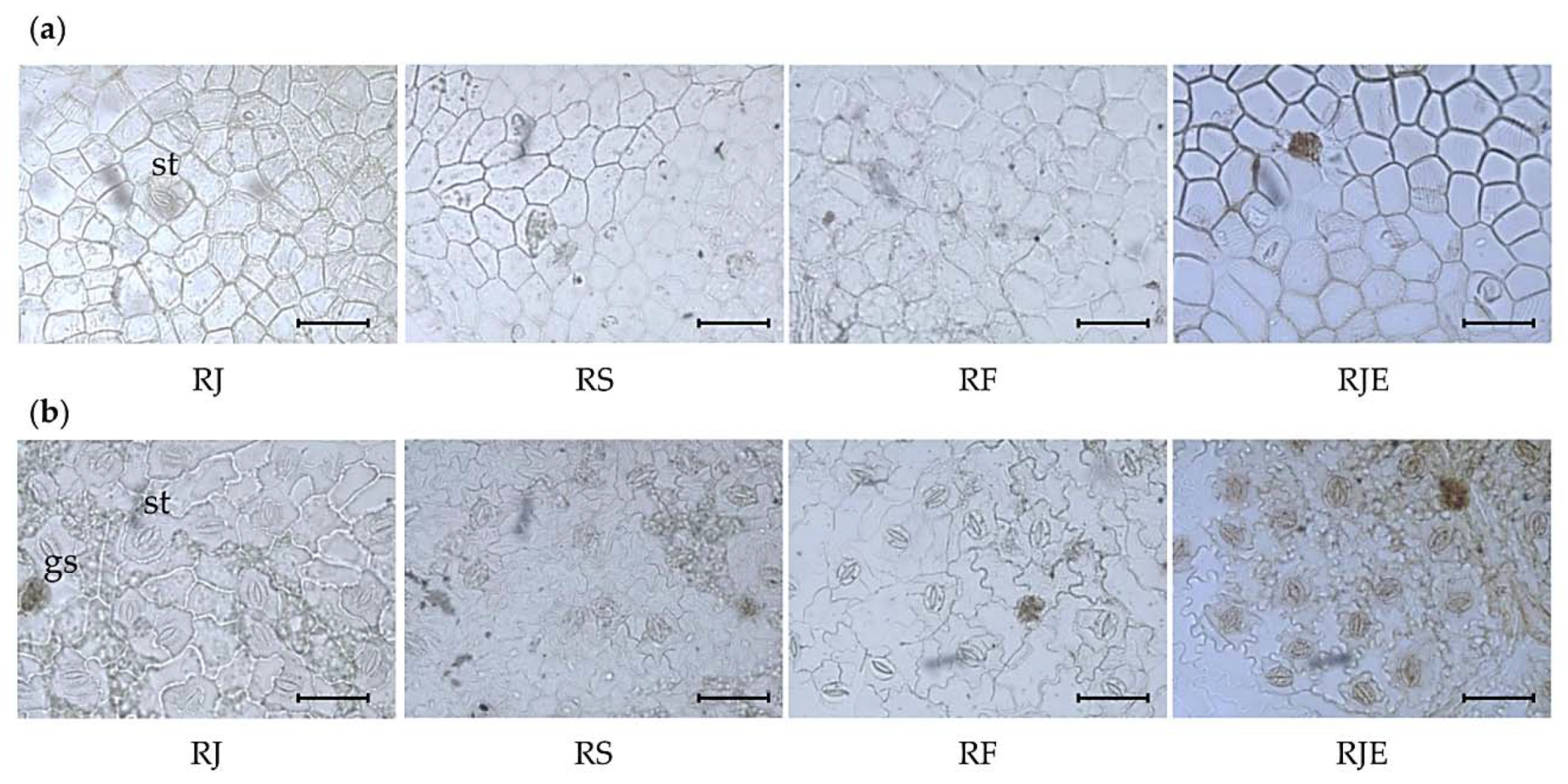
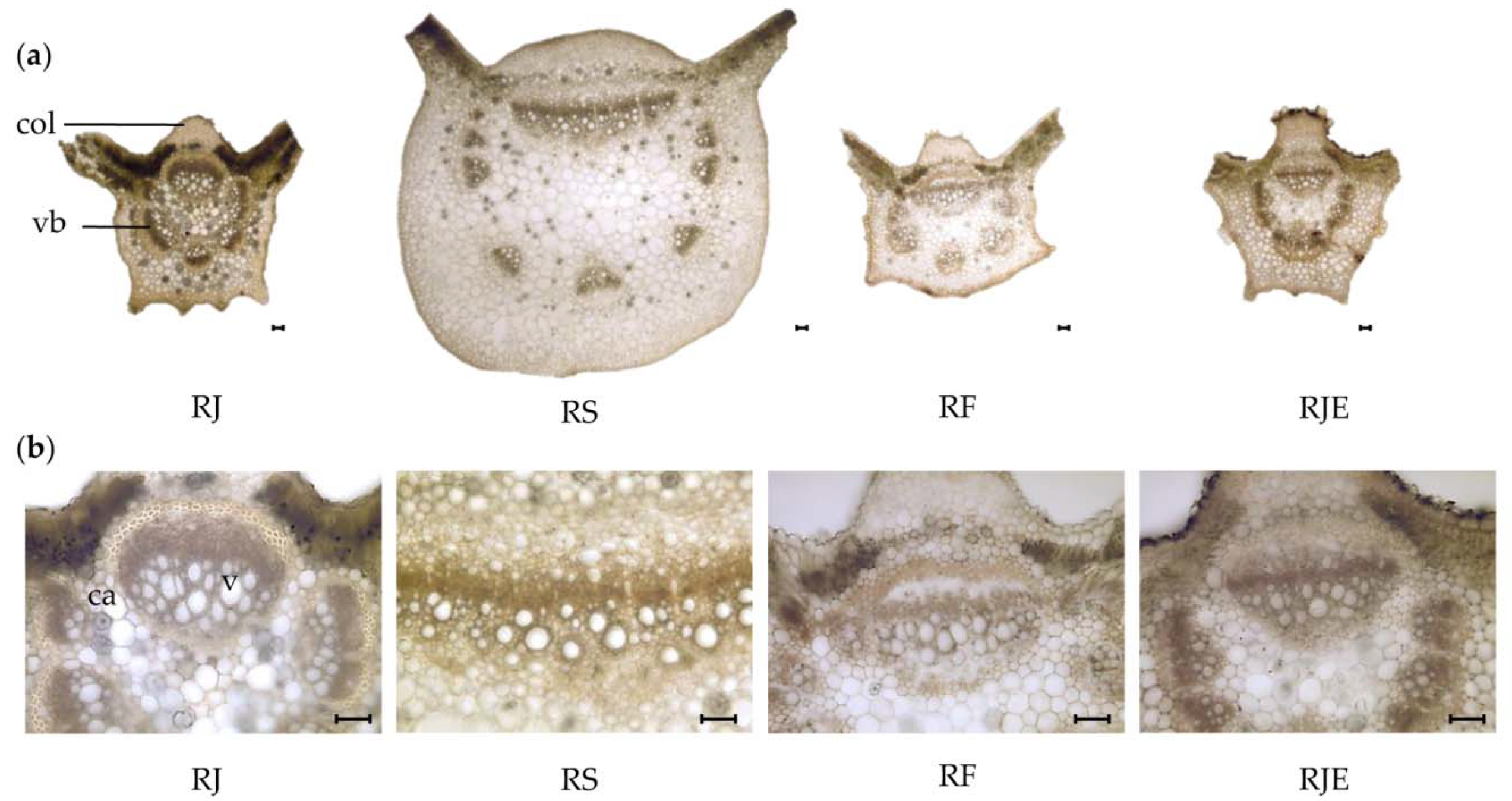
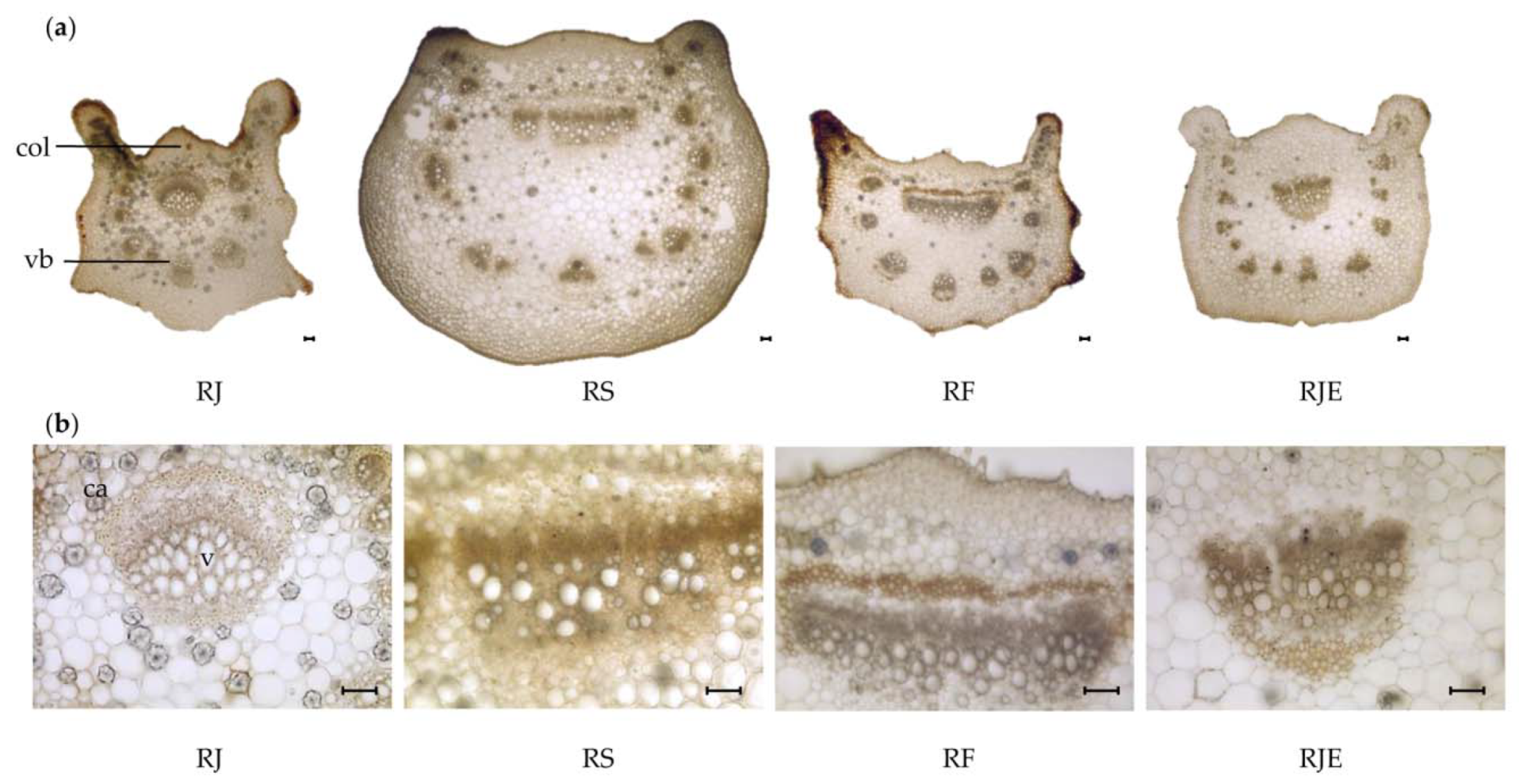
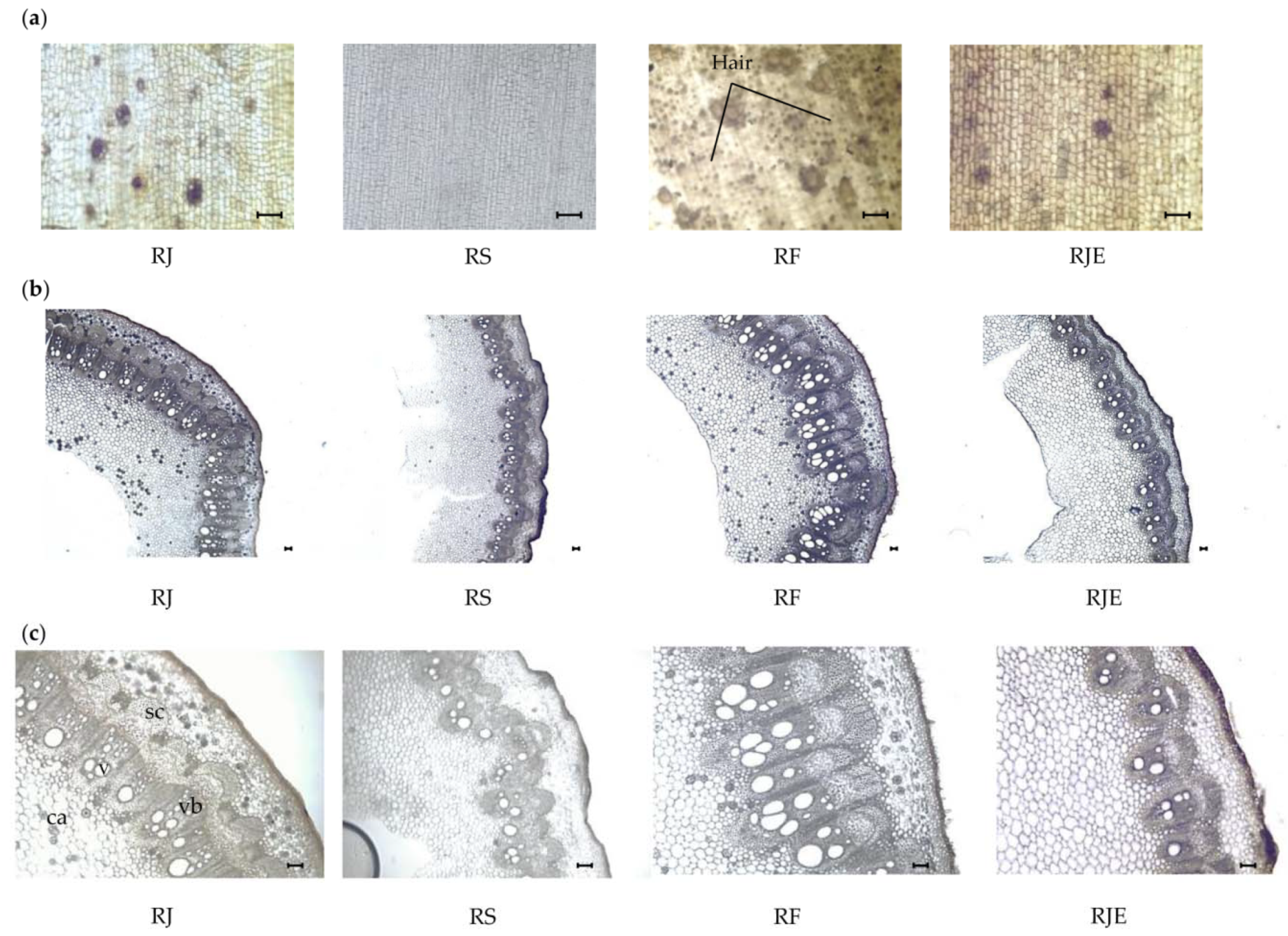
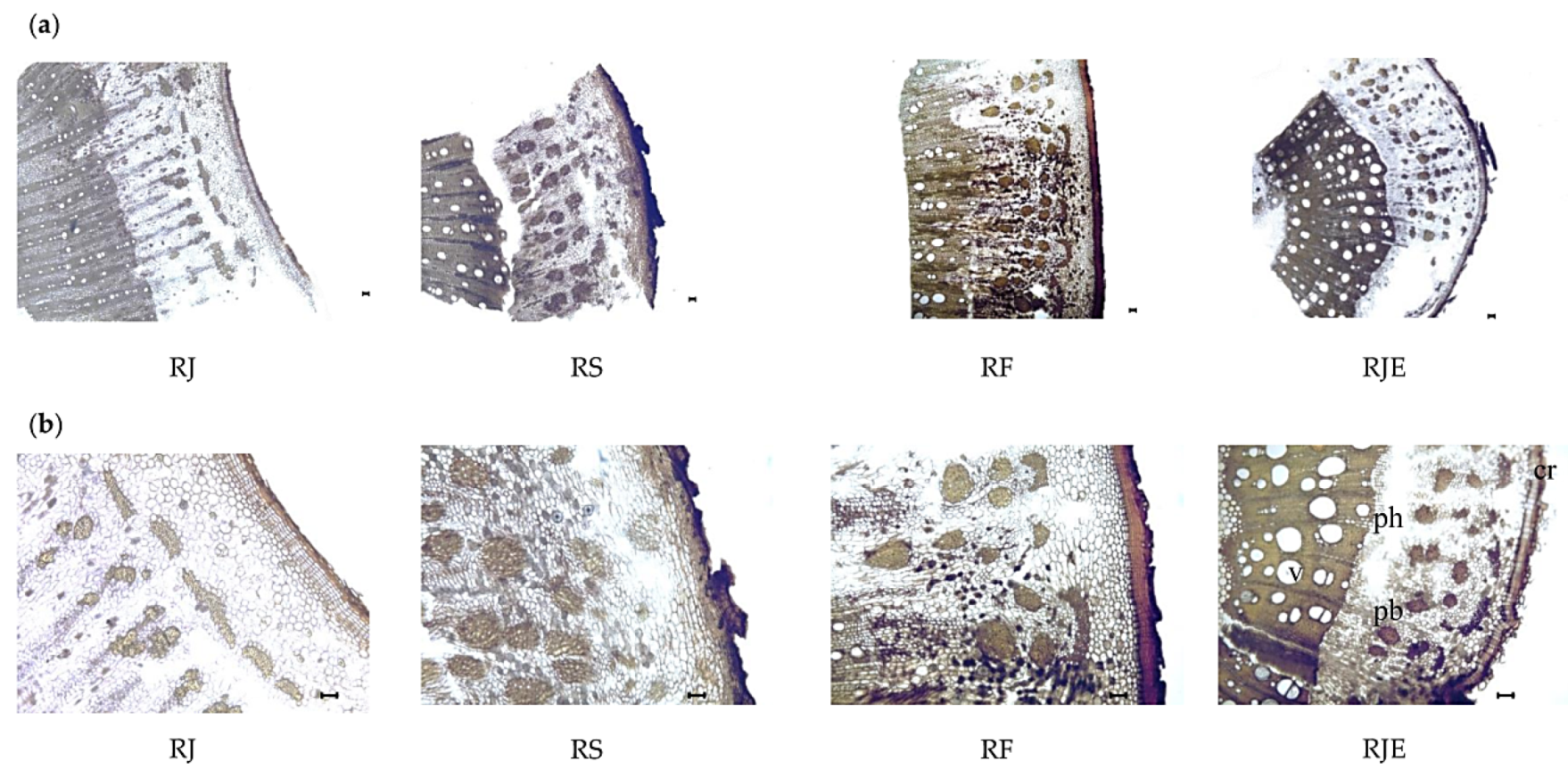
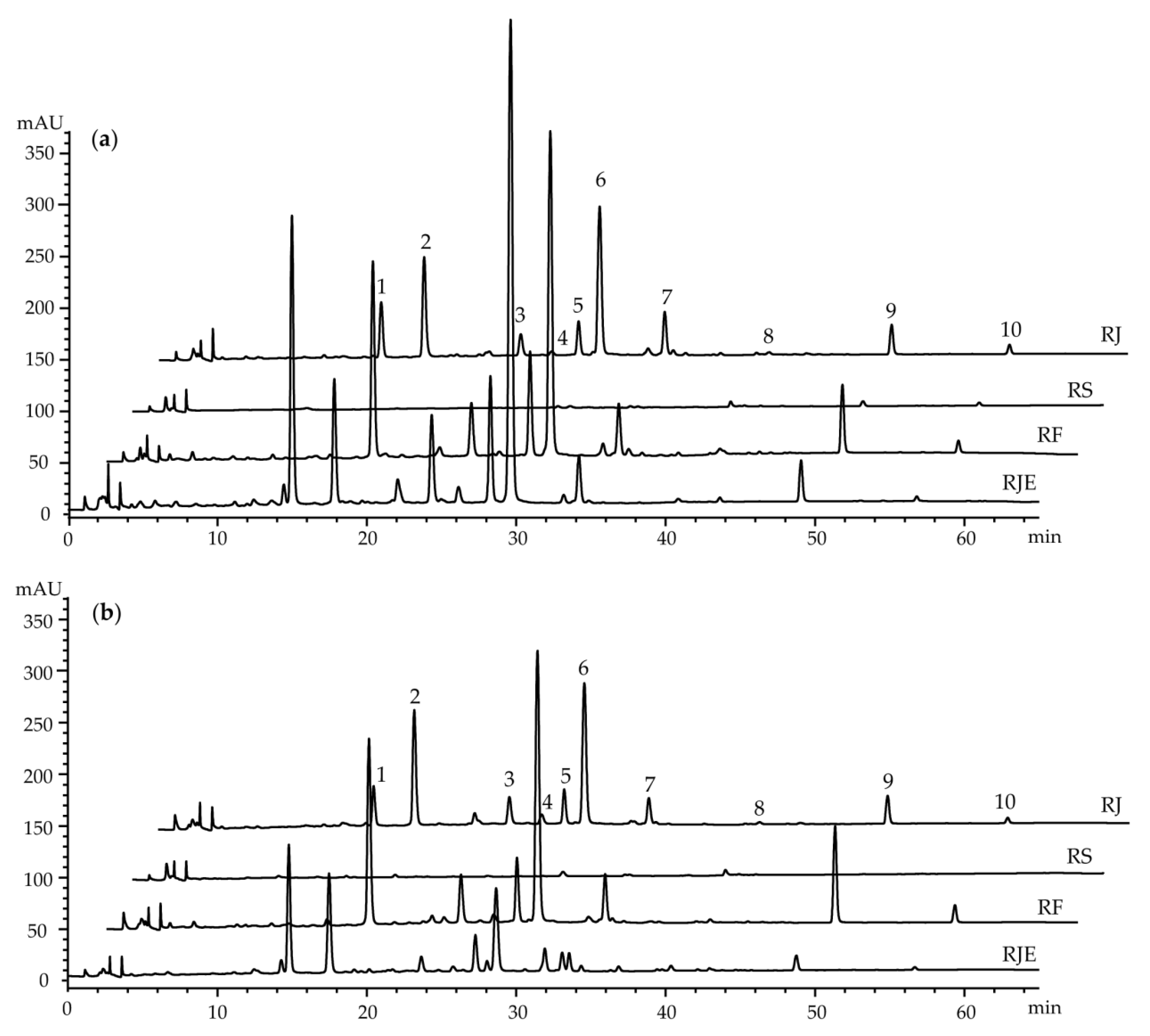
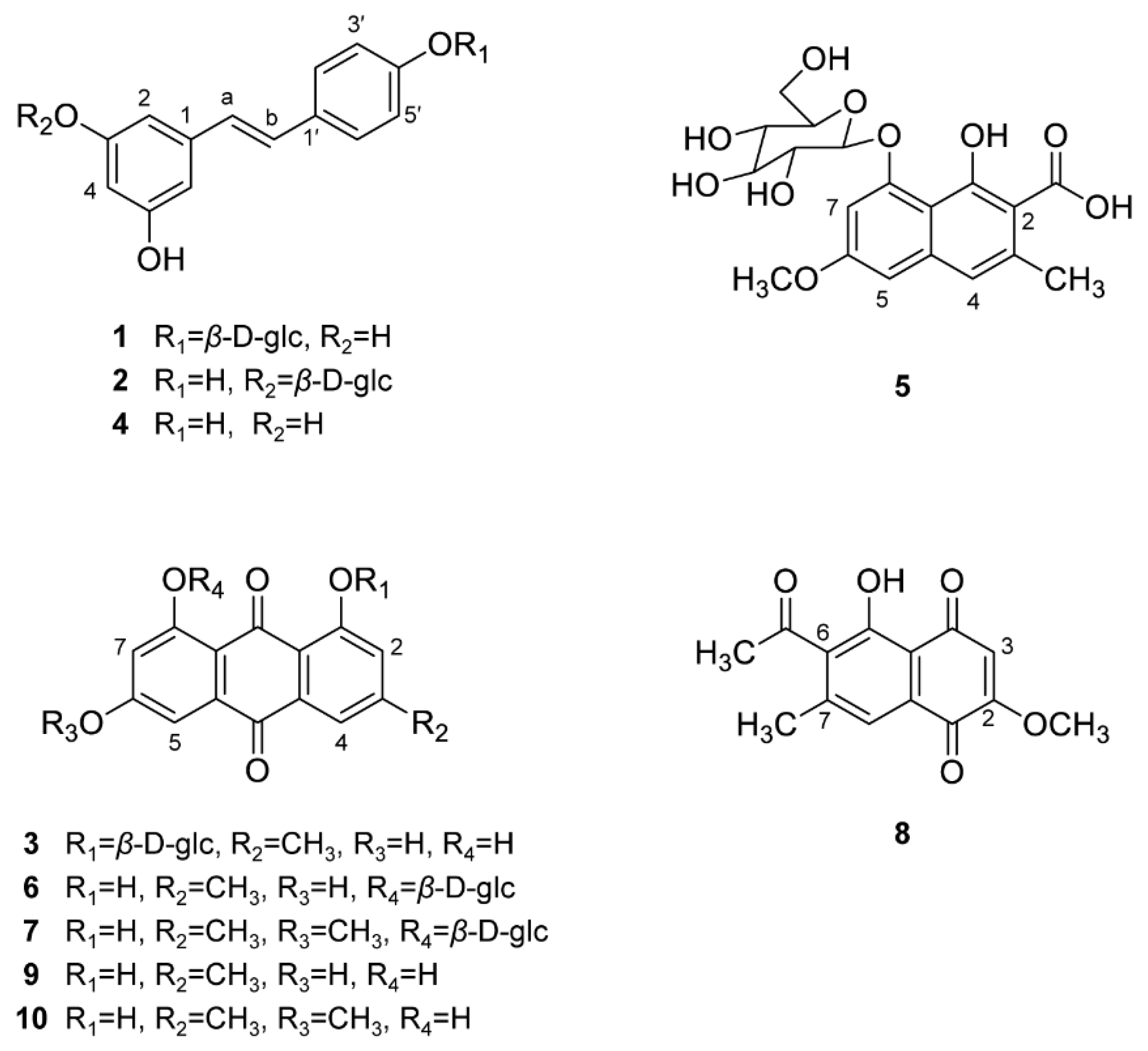

| Parameters | RJ | RS | RF | RJE |
|---|---|---|---|---|
| Stomatal shape | anisocytic | anomocytic | Anisocytic | Anisocytic |
| Stomatal index | 16 ± 1 b | 19 ± 2 a | 17 ± 1 b | 15 ± 1 b |
| Frequency of stomata (in mm2) | 26 ± 4 a | 19 ± 3 b | 29 ± 5 a | 29 ± 4 a |
| Cell number in glandular scale | eight | four or eight | four or eight | four, six or eight |
| Parameters | RJ | RS | RF | RJE |
|---|---|---|---|---|
| Ratio of adaxial/abaxial height | 0.21 ± 0.02 b | 0.13 ± 0.02 c | 0.22 ± 0.02 b | 0.29 ± 0.02 a |
| Number of vascular bundles | 7 ± 1 b | 10 ± 1 a | 7 ± 1 b | 7 ± 1 b |
| Length of the vascular bundle in the center (µm) | 405 ± 60 b | 565 ± 75 a | 350 ± 45 b | 400 ± 70 b |
| Width of the vascular bundle in the center (µm) | 525 ± 130 b | 1235 ± 230 a | 580 ± 100 b | 570 ± 95 b |
| Frequency of druse (in mm2) | 36 ± 10 a | 12 ± 4 c | 20 ± 6 b | 4 ± 2 d |
| Parameters | RJ | RS | RF | RJE |
|---|---|---|---|---|
| Ratio of adaxial/abaxial height | 0.10 ± 0.04 a | 0.04 ± 0.02 b | 0.11 ± 0.03 a | 0.12 ± 0.03 a |
| Number of vascular bundles | 13 ± 2 a | 15 ± 2 a | 11 ± 1 b | 13 ± 2 a |
| Length of the vascular bundle in the center (µm) | 535 ± 50 b | 700 ± 40 a | 460 ± 40 b | 455 ± 40 b |
| Width of the vascular bundle in the center (µm) | 635 ± 70 c | 1335 ± 130 a | 800 ± 100 b | 600 ± 85 c |
| Frequency of druse (in mm2) | 35 ± 9 a | 10 ± 5 c | 22 ± 6 b | 3 ± 2 d |
| Parameters | RJ | RS | RF | RJE |
|---|---|---|---|---|
| Frequency of hair (in mm2) | 0 | 0 | 81 ± 10 a | 0 |
| Number of vascular bundles | 95 ± 20 b | 130 ± 10 a | 110 ± 10 ab | 65 ± 10 c |
| Diameter of vascular bundles (µm) | 843 ± 175 b | 506 ± 101 c | 1000 ± 140 a | 536 ± 108 bc |
| Frequency of druse (in mm2) | 25 ± 10 a | 4 ± 3 c | 10 ± 2 b | 2 ± 2 c |
| Frequency of sclerenchyma cells (in mm²) | 250 ± 35 a | 152 ± 32 c | 264 ± 34 a | 192 ± 33 b |
| Vessel diameter (µm) | 117 ± 10 b | 75 ± 20 c | 140 ± 35 a | 75 ± 15 c |
| Parameters | RJ | RS | RF | RJE |
|---|---|---|---|---|
| Size of cork cell (length × width, µm) | 20 ± 3 a × 45 ± 5 b | 10 ± 2 c × 55 ± 5 a | 15 ± 2 b × 45 ± 10 b | 10 ± 1 c × 40 ± 10 b |
| Number of cork cell layers | 9–12 a | 6–8 b | 7–10 a | 4–6 c |
| Frequency of pericycle bundles (in mm2) | 8 ± 2 b | 7 ± 1 b | 5 ± 2 b | 12 ± 3 a |
| Vessel diameter (µm) | 95 ± 35 b | 139 ± 27 a | 113 ± 19 b | 111 ± 20 b |
| Frequency of vessels (in mm2) | 23 ± 5 b | 15 ± 2 c | 15 ± 2 c | 30 ± 5 a |
| Compounds | Season | RJ | RS | RF | RJE |
|---|---|---|---|---|---|
| Resveratroloside (1) | Before | 19.6 ± 2.15 b | ND | ND | 75.1 ± 4.26 a |
| After | 11.2 ± 0.26 b | ND | ND | 34.5 ± 0.67 a | |
| Polydatin (picein) (2) | Before | 11.9 ± 0.64 b | 0.05 ± 0.01 c | 24.7 ± 0.40 a | 13.0 ± 0.77 b |
| After | 13.4 ± 0.41 b | 0.29 ± 0.01 d | 21.8 ± 0.60 a | 11.0 ± 0.21 c | |
| Emodin-1-O-β-D-glucoside (3) | Before | 0.54 ± 0.02 c | ND | 1.28 ± 0.03 b | 2.30 ± 0.08 a |
| After | 0.75 ± 0.05 b | ND | 1.17 ± 0.10 a | 0.37 ± 0.07 c | |
| trans-Resveratrol (4) | Before | 0.69 ± 0.03 b | ND | 0.70 ± 0.05 b | 2.04 ± 0.18 a |
| After | 1.69 ± 0.27 a | ND | 1.34 ± 0.08 b | 0.76 ± 0.05 c | |
| Naphthalene glucoside (5) | Before | 1.22 ± 0.06 c | ND | 3.72 ± 0.21 a | 2.90 ± 0.08 b |
| After | 1.05 ± 0.06 b | ND | 2.17 ± 0.10 a | 1.15 ± 0.20 b | |
| Emodin-8-O-β-D-glucoside (6) | Before | 5.23 ± 0.28 c | 0.10 ± 0.01 d | 13.1 ± 0.49 b | 16.8 ± 0.23 a |
| After | 5.63 ± 0.11 b | 0.13 ± 0.01 d | 12.3 ± 0.69 a | 3.35 ± 0.63 c | |
| Physcion-8-O-β-D-glucoside (7) | Before | 1.30 ± 0.04 c | 0.03 ± 0.00 d | 1.91 ± 0.08 a | 1.50 ± 0.14 b |
| After | 0.81 ± 0.03 b | 0.02 ± 0.00 d | 1.66 ± 0.06 a | 0.64 ± 0.05 c | |
| 2-methoxy-6-acetyl-7-methyljuglone (8) | Before | 0.04 ± 0.00 c | ND | 0.18 ± 0.01 a | 0.10 ± 0.00 b |
| After | 0.04 ± 0.01 b | ND | 0.12 ± 0.02 a | 0.12 ± 0.01 a | |
| Emodin (9) | Before | 0.70 ± 0.06 b | 0.11 ± 0.01 c | 1.30 ± 0.09 a | 0.71 ± 0.04 b |
| After | 0.58 ± 0.05 b | ND | 2.09 ± 0.03 a | 0.34 ± 0.03 c | |
| Physcion (10) | Before | 0.18 ± 0.02 a | 0.04 ± 0.01 b | 0.21 ± 0.03 a | 0.05 ± 0.01 b |
| After | 0.07 ± 0.01 b | ND | 0.24 ± 0.02 a | 0.05 ± 0.01 b |
| Botanical Name | Collection Place (Latitude, Longitude) | Collection Year | Voucher Specimens No. | Abbre- Viations |
|---|---|---|---|---|
| R. japonica Houtt. | Sancheong (35°18′00.4″ N, 127°58′20.9″ E) Jinju (35°10′19.8″ N, 128°05′48.6″ E) (35°13′00.6″ N, 128°01′39.5″ E) | 2016-2018 | PGSC-210 | RJ |
| R. sachalinensis (F.Schmidt) Nakai | Ulleung island (37°27′51.4″ N, 130°52′20.4″ E) (37°27′53.8″ N, 130°52′21.6″ E) Jinju (35°08′55.1″ N, 128°05′49.6″ E) | 2016-2018 | PGSC-211 | RS |
| R. forbesii (Hance) T. Yamaz | Seoul (37°42′46.3″ N, 126°49′07.3″ E) Jinju (35°08′55.3″ N, 128°05′49.4″ E) (35°12′55.2″ N, 128°04′08.7″ E) | 2016-2018 | PGSC-212 | RF |
| R. japonica for. elata | Jeju island (33°20′49.9″ N, 126°29′47.0″ E) (33°20′41.4″ N, 126°29′40.9″ E) Jinju (35°08′55.6″ N, 128°05′49.6″ E) | 2016-2018 | PGSC-213 | RJE |
© 2020 by the authors. Licensee MDPI, Basel, Switzerland. This article is an open access article distributed under the terms and conditions of the Creative Commons Attribution (CC BY) license (http://creativecommons.org/licenses/by/4.0/).
Share and Cite
Khalil, A.A.K.; Akter, K.-M.; Kim, H.-J.; Park, W.S.; Kang, D.-M.; Koo, K.A.; Ahn, M.-J. Comparative Inner Morphological and Chemical Studies on Reynoutria Species in Korea. Plants 2020, 9, 222. https://doi.org/10.3390/plants9020222
Khalil AAK, Akter K-M, Kim H-J, Park WS, Kang D-M, Koo KA, Ahn M-J. Comparative Inner Morphological and Chemical Studies on Reynoutria Species in Korea. Plants. 2020; 9(2):222. https://doi.org/10.3390/plants9020222
Chicago/Turabian StyleKhalil, Atif Ali Khan, Kazi-Marjahan Akter, Hye-Jin Kim, Woo Sung Park, Dong-Min Kang, Kyung Ah Koo, and Mi-Jeong Ahn. 2020. "Comparative Inner Morphological and Chemical Studies on Reynoutria Species in Korea" Plants 9, no. 2: 222. https://doi.org/10.3390/plants9020222
APA StyleKhalil, A. A. K., Akter, K.-M., Kim, H.-J., Park, W. S., Kang, D.-M., Koo, K. A., & Ahn, M.-J. (2020). Comparative Inner Morphological and Chemical Studies on Reynoutria Species in Korea. Plants, 9(2), 222. https://doi.org/10.3390/plants9020222







